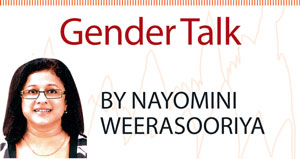02 Dec 2016 - {{hitsCtrl.values.hits}}
 Sonali (not her real name) is a 26-year-old merchandiser who works for one of Sri Lanka’s largest apparel groups that takes pride in its commitment to gender relations and women’s empowerment. She travels to her office outside Colombo on the Negombo Road, spending a considerable amount of time in traffic. Once in office, she rarely gets even a proper lunch break. Her workload doesn’t end till about 9:00 p.m.; she leaves for home, exhausted.
Sonali (not her real name) is a 26-year-old merchandiser who works for one of Sri Lanka’s largest apparel groups that takes pride in its commitment to gender relations and women’s empowerment. She travels to her office outside Colombo on the Negombo Road, spending a considerable amount of time in traffic. Once in office, she rarely gets even a proper lunch break. Her workload doesn’t end till about 9:00 p.m.; she leaves for home, exhausted.
Her mother says that when she gets home, all she does is fall asleep on the couch, often without dinner, in her work clothes. She must then wake up around 2:00 a.m. or 3:00 a.m. to do some more work before grabbing a hurried breakfast and running off to work.
Sonali is studying for an MBA and finds that she cannot lead a normal life due to the hectic work schedule she is forced to engage in by her superiors. She is considering leaving the apparel sector for good. Before her, there were other girls who faced the same fate and left – a few were hospitalized for overwork and stress.
Sonali’s story, when I heard it, revealed to me the dark world of the apparel sector middle-level workers in Sri Lanka. They are not the sweatshop workers or the overworked garment workers whose plight has been recorded and studied many times over. They come often from the city and middle-class families – and were happy initially to be able to work for the garment giants whose glossy stories tell of a glorious commitment to ensuring gender relations at work. But in reality, turns out to be a sad story.
Where does Sonali and other women like her fit into their beautifully crafted gender story? Or are there holes in their gender stories that are aimed at finding favour with global buyers but are in fact, not really true? How come that in this day and age, when buyers scrutinize every aspect of the manufacturing process, that this kind of exploitation goes unnoticed? These are questions we should be asking ourselves, especially since Sri Lanka is about to get great exposure once again on the global apparel stage.
Exploited way beyond?
Granted, Sonali works for an industry that must rely on tight deadlines and global timelines. Some might even say that it comes with the industry landscape and is to be expected. But the way Sonali and other young girls like her, brimming with hope and plans for the future, are overworked, it makes you wonder whether they are being exploited way beyond what the industry requires of them.
Although the garment sector takes pride in the various goodwill programmes they have created for the women who do the bulk of the sewing and cutting, etc., there seems to be a gap in providing a similar service for the middle ranks. Food for thought when you hear of Sonali’s story. There are hundreds like her – too exhausted to do anything else but work, too scared to speak up and unable to give up their jobs because they need the money. They have become a disillusioned lot and speak of nothing but misery among their ranks at work.
Sri Lanka is facing crucial economic times – as GSP Plus looms on the horizon and the garment sector can be confident in better times coming, it is perhaps the right time to examine what more can be done to better manage the workload of the middle ranks. It would certainly be a safer option than having a crisis among middle ranks explode on the global stage – the same way Beyonce’s range being manufactured in Sri Lanka was criticized for sweatshop conditions.
We live in a day and age when a single Tweet can endanger business potential – a story that breaks on the Internet, whether true or not, can be shared and go viral with disastrous consequences for the garment industry and the country. By reviewing the current work patterns and workloads, the apparel sector bosses can hopefully avoid a possible future disaster.
As a mature industry in which women have served for over a decade, the garment industry owes itself a review of its ranks and the way its top management provides work schedules for the staff. Sonali’s story highlights gaps that definitely need to be addressed by the industry experts who must find solutions. Solutions that would make sure that young women like Sonali are not run down and hounded down with work and more work but encouraged and empowered to give their best to their companies, the apparel sector and the country.
(Nayomini Weerasooriya, a senior journalist, writer and a PR professional, can be contacted at [email protected])
10 Jan 2025 3 minute ago
10 Jan 2025 19 minute ago
10 Jan 2025 34 minute ago
10 Jan 2025 39 minute ago
10 Jan 2025 1 hours ago